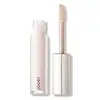Jouer Cosmetics Essential High Coverage Liquid Concealer Versus Jouer Cosmetics Essential High Coverage Concealer Pen
What's inside
What's inside
 Key Ingredients
Key Ingredients

 Benefits
Benefits

 Concerns
Concerns

 Ingredients Side-by-side
Ingredients Side-by-side

Cyclopentasiloxane
EmollientWater
Skin ConditioningButylene Glycol
HumectantPvp
Emulsion StabilisingPhenyl Trimethicone
Skin ConditioningCetyl PEG/PPG-10/1 Dimethicone
EmulsifyingPEG-10 Dimethicone
Skin ConditioningVinyl Dimethicone/Methicone Silsesquioxane Crosspolymer
Quaternium-18 Hectorite
Sorbitan Isostearate
EmulsifyingDimethicone
EmollientSodium Chloride
MaskingTriethoxycaprylylsilane
Caprylyl Glycol
EmollientPhenoxyethanol
PreservativeCitric Acid
BufferingSorbitol
Humectant1,2-Hexanediol
Skin ConditioningPropanediol
SolventSodium Phytate
Illicium Verum Fruit Extract
PerfumingTocopheryl Acetate
AntioxidantSodium Hyaluronate
HumectantEuterpe Oleracea Fruit Extract
CI 77891
Cosmetic ColorantCI 77491
Cosmetic ColorantCI 77492
Cosmetic ColorantCI 77499
Cosmetic ColorantCyclopentasiloxane, Water, Butylene Glycol, Pvp, Phenyl Trimethicone, Cetyl PEG/PPG-10/1 Dimethicone, PEG-10 Dimethicone, Vinyl Dimethicone/Methicone Silsesquioxane Crosspolymer, Quaternium-18 Hectorite, Sorbitan Isostearate, Dimethicone, Sodium Chloride, Triethoxycaprylylsilane, Caprylyl Glycol, Phenoxyethanol, Citric Acid, Sorbitol, 1,2-Hexanediol, Propanediol, Sodium Phytate, Illicium Verum Fruit Extract, Tocopheryl Acetate, Sodium Hyaluronate, Euterpe Oleracea Fruit Extract, CI 77891, CI 77491, CI 77492, CI 77499
Triethylhexanoin
MaskingCeresin
Emulsion StabilisingPhytosteryl Isostearyl Dimer Dilinoleate
EmollientIsocetyl Myristate
EmollientVegetable Oil
Skin ConditioningLimnanthes Alba Seed Oil
Skin ConditioningDipentaerythrityl Hexahydroxystearate/Hexastearate/Hexarosinate
Skin ConditioningMethyl Methacrylate Crosspolymer
Mica
Cosmetic ColorantPolyglyceryl-2 Triisostearate
EmulsifyingSynthetic Beeswax
Emulsion StabilisingHydrogenated Coco-Glycerides
EmollientCera Microcristallina
Emulsion StabilisingSucrose Tetrastearate Triacetate
EmollientCopernicia Cerifera Cera
EmollientCaprylyl Glycol
EmollientGlycerin
HumectantCaprylhydroxamic Acid
BHT
AntioxidantArbutin
AntioxidantHydrolyzed Hyaluronic Acid
HumectantTocopherol
AntioxidantButylene Glycol
HumectantWater
Skin ConditioningResveratrol
AntioxidantCI 77891
Cosmetic ColorantCI 77491
Cosmetic ColorantCI 77492
Cosmetic ColorantCI 77499
Cosmetic ColorantTriethylhexanoin, Ceresin, Phytosteryl Isostearyl Dimer Dilinoleate, Isocetyl Myristate, Vegetable Oil, Limnanthes Alba Seed Oil, Dipentaerythrityl Hexahydroxystearate/Hexastearate/Hexarosinate, Methyl Methacrylate Crosspolymer, Mica, Polyglyceryl-2 Triisostearate, Synthetic Beeswax, Hydrogenated Coco-Glycerides, Cera Microcristallina, Sucrose Tetrastearate Triacetate, Copernicia Cerifera Cera, Caprylyl Glycol, Glycerin, Caprylhydroxamic Acid, BHT, Arbutin, Hydrolyzed Hyaluronic Acid, Tocopherol, Butylene Glycol, Water, Resveratrol, CI 77891, CI 77491, CI 77492, CI 77499
 Reviews
Reviews

Alternatives
Ingredients Explained
These ingredients are found in both products.
Ingredients higher up in an ingredient list are typically present in a larger amount.
Butylene Glycol (or BG) is used within cosmetic products for a few different reasons:
Overall, Butylene Glycol is a safe and well-rounded ingredient that works well with other ingredients.
Though this ingredient works well with most skin types, some people with sensitive skin may experience a reaction such as allergic rashes, closed comedones, or itchiness.
Learn more about Butylene GlycolCaprylyl Glycol is a humectant and emollient, meaning it attracts and preserves moisture.
It is a common ingredient in many products, especially those designed to hydrate skin. The primary benefits are retaining moisture, skin softening, and promoting a healthy skin barrier.
Though Caprylyl Glycol is an alcohol derived from fatty acids, it is not the kind that can dry out skin.
This ingredient is also used as a preservative to extend the life of products. It has slight antimicrobial properties.
Learn more about Caprylyl GlycolCi 77491 is also hydrated iron III oxide. It's sole purpose is to give a red/pink hue to products.
Iron III oxides are classified as inorganic chemicals for coloring.
Synthetically created Ci 77491 is considered safer than those naturally found. This is because the synthetically created version may contain less impurities. Iron oxides are generally non-toxic and non-allergenic.
Learn more about CI 77491Ci 77492 is also hydrated iron III oxide. It's sole purpose is to give a yellow hue to products.
Iron III oxides are classified as inorganic chemicals for coloring.
Synthetically created Ci 77492 is considered safer than those naturally found. This is because the synthetically created version may contain less impurities. Iron oxides are generally non-toxic and non-allergenic.
Learn more about CI 77492Ci 77499 is also hydrated iron III oxide. It is created from mixing red and black iron oxides. This helps give shades of darkness to a product.
Iron III oxides are classified as inorganic chemicals for coloring.
Ci 77891 is a white pigment from Titanium dioxide. It is naturally found in minerals such as rutile and ilmenite.
It's main function is to add a white color to cosmetics. It can also be mixed with other colors to create different shades.
Ci 77891 is commonly found in sunscreens due to its ability to block UV rays.
Learn more about CI 77891Water. It's the most common cosmetic ingredient of all. You'll usually see it at the top of ingredient lists, meaning that it makes up the largest part of the product.
So why is it so popular? Water most often acts as a solvent - this means that it helps dissolve other ingredients into the formulation.
You'll also recognize water as that liquid we all need to stay alive. If you see this, drink a glass of water. Stay hydrated!
Learn more about Water